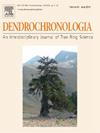在夏季变热的过程中,有管理的幼栎比无管理的老栎生长同步性和对干旱的响应性更高
IF 2.7
3区 农林科学
Q1 FORESTRY
引用次数: 0
摘要
历史管理遗产可能制约森林对气候变暖的近期反应。在东欧,独特而保存完好的古老无柄橡树林仍然存在。对于正在经历持续干旱化的地区的年轻管理森林而言,它们是比较其径向生长对气候变率,特别是干旱压力的反应的理想环境。我们评估了三个以无梗栎(Quercus petaea, Matt.)为主的林分的径向生长变异性及其对气候变量的响应。位于罗马尼亚西部:一个非常古老的无人管理的林分,一个来自种子起源的老管理林分和一个来自发芽起源的年轻管理林分。从20世纪80年代开始,气候条件向更温暖、更干燥的方向转变,这可能有助于降低时间生长变异性,但并没有增加共存树木之间的生长一致性。太古林和老林的生长变异性高于幼林,幼林表现出更高的生长同步性。温暖干燥的夏季和升高的蒸汽压赤字减少了无根橡树的生长。在夏季结束的12个月的干旱中,年轻和年老的管理林分的生长指数响应性最高,而非常老的未管理林分的响应性最低。改善年轻甚至老的管理林分的树木生长可能使它们对夏季土壤和大气干旱更敏感,从而增加它们对进一步缺水的脆弱性。需要更好地了解橡树的生长变异性和对干旱的响应如何取决于根冠比,以管理橡树林并使其更能适应干旱化。本文章由计算机程序翻译,如有差异,请以英文原文为准。
Higher growth synchrony and responsiveness to drought in managed-young than in unmanaged-old sessile oak stands during a shift to hotter summers
Historical management legacies may condition recent responses of forests to climate warming. In Eastern Europe, unique and well-preserved old-growth sessile oak forests remain. They represent a perfect setting for comparing their radial-growth responses to climate variability, particularly drought stress, with respect to younger managed forests in a region experiencing ongoing aridification. We assessed radial-growth variability and responses to climate variables in three stands dominated by sessile oak (Quercus petraea (Matt.) Liebl.) located in western Romania: a very old unmanaged stand, an old managed stand from seed origin and a young managed stand from sprout origin. There was a shift towards warmer and drier conditions from the 1980s onwards which could have contributed to reduce temporal growth variability, but it did not increase growth coherence among coexisting trees. Very old and old stands showed a higher growth variability among conspecifics comparing with the young stand, which presented a higher growth synchrony. Warm and dry summers and elevated vapor pressure deficit reduced sessile oak growth. The highest responsiveness of growth indices was found for 12-month long droughts ending in summer in the case of young and old managed stands, whereas the very old unmanaged stand showed the lowest responsiveness. Improving tree growth of younger and even old managed stands may make them more responsive to summer soil and atmospheric drought, thus increasing their vulnerability to further water shortage. A better knowledge on how oak growth variability and responsiveness to drought depend on root-to-shoot ratios is needed to manage oak forests and make them more resilient to aridification.
求助全文
通过发布文献求助,成功后即可免费获取论文全文。
去求助
来源期刊

Dendrochronologia
FORESTRY-GEOGRAPHY, PHYSICAL
CiteScore
5.50
自引率
13.30%
发文量
82
审稿时长
22.8 weeks
期刊介绍:
Dendrochronologia is a peer-reviewed international scholarly journal that presents high-quality research related to growth rings of woody plants, i.e., trees and shrubs, and the application of tree-ring studies.
The areas covered by the journal include, but are not limited to:
Archaeology
Botany
Climatology
Ecology
Forestry
Geology
Hydrology
Original research articles, reviews, communications, technical notes and personal notes are considered for publication.
 求助内容:
求助内容: 应助结果提醒方式:
应助结果提醒方式:


